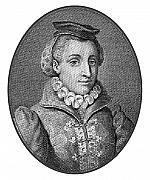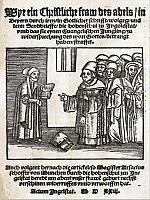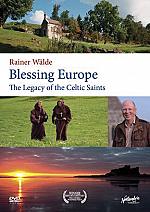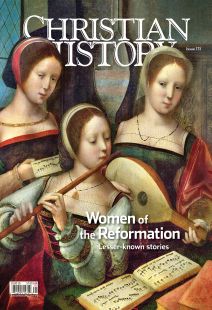Dangerous pamphlets
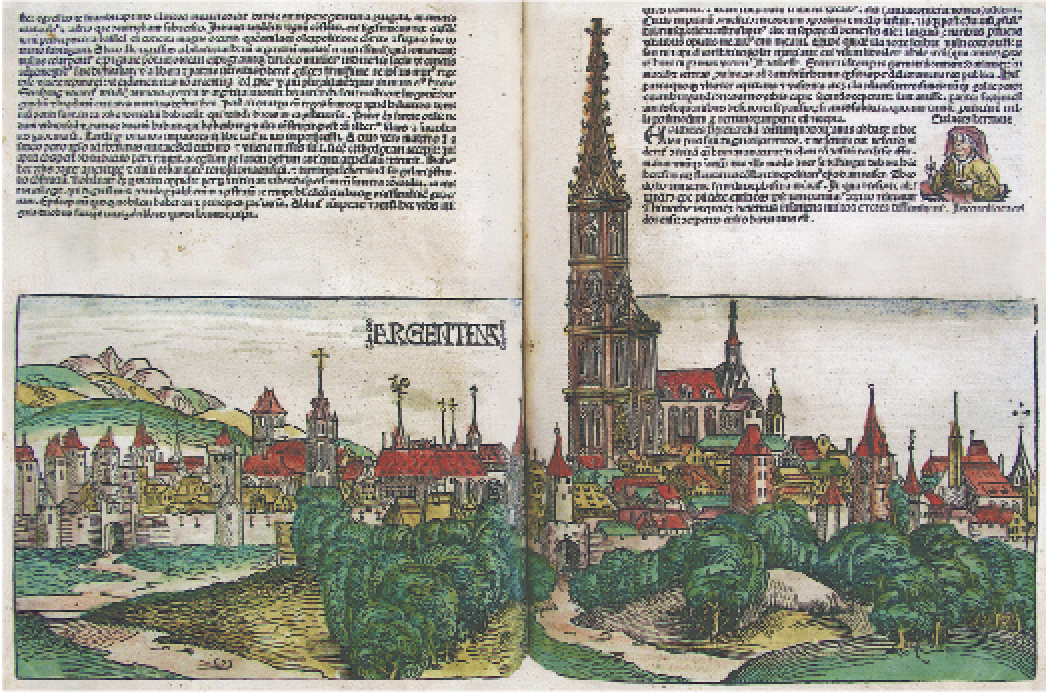
[Strasbourg a decade before Prüss's birth]
BORN INTO A FAMILY that owned a printing press, Margarethe Prüss (d. 1542) grew up with the smell of ink and the steady clacking sound of the press at work.
As the daughter of a master printer, wife of a printer—not just once but three times—and mother-in-law of yet another printer, she also became a printer in her own right, highly unusual for her time. Between her marriages she used special widow’s privileges to manage a printing house independently during some of the most turbulent times of the Reformation. Between 1522 and 1527, the years of rebelling peasants and vigorous unauthorized lay pamphlet writing, Prüss played an instrumental role in spreading the seeds of reform.
Publishers had to calculate the risks of printing the words of those considered “radical.” Prüss wielded significant power by providing some of the most radical voices of the time with a platform—especially Anabaptists, the most persecuted of all.
Pamphlets and radicals
The Prüss family business had the fortune of operating in one of the free imperial cities. Strasbourg, with autonomy from territorial princes, was directly subordinate only to the emperor of the Holy Roman Empire. In many ways a publisher’s dream and known for its tolerant vibes, the city attracted prophetic groups and radical voices of the Reformation.
These radicals were charismatic groups and individuals who, though influenced by Reformation teachings, broke away from many traditions preserved by those who would become known as the magisterial Reformers. The radicals celebrated the experience of the Holy Spirit speaking to and through individuals and were explicitly Spirit-led communities, with fewer institutional structures for religious expression. They refused to give an oath or serve in the army, which made them suspect in the eyes of authorities.
Also suspicious was how, in their early stages, they welcomed women’s participation and even leadership as prophets. Most of all such groups were considered a threat because they broke the imperial law of infant baptism by practicing believer’s baptism. These “Anabaptists” (or “re-baptizers”), as they were called, suffered heavy persecution by other reforming groups and Catholics alike.
In Strasbourg Anabaptist or Spiritualist movements constituted about 10 percent of the city’s population. Women figured prominently, including in the circle of visiting Anabaptist leader Melchior Hoffman (c. 1495–c. 1543). His followers included several prophetic women, such as Barbara Rebstock, wife of a weaver; and Ursula Jost (d. 1532 or 1539). Prüss directly supported Jost with her publishing decisions during the heat of Reformation pamphlet writing.
Jost, from Illkirch, south of Strasbourg, was the illiterate wife of Lienhard Jost, a butcher who was also a prophet; they had eight children. Her visionary prophetic activity lasted several years (1525–1532). A total of 77 of her apocalyptic visions were recorded with the involvement of Hoffman, who considered her message as important as that of the prophets of the Old Testament. Prüss’s printing shop published Jost’s Prophetic Visions and Revelation of the Works of God in these End Times (1530). Little else is known of Jost’s life. Even her death date is ambiguous; all we know is that Lienhard married another woman, Agnes, in 1539.
Even in Strasbourg publishing these Anabaptists’ works was a dangerous business. In fact anything not flowing from or supporting Catholic teachings brought a certain level of notoriety to a publisher. Printers who decided to publish such materials risked not only financial ruin due to censorship, but their very lives as well. Nevertheless Prüss continued her work.
The family trade
Prüss inherited the family printing business after her father died. Johannes Prüss Sr. (1447–1510), a devout Catholic, had been printing since 1480. He produced mostly missals and breviaries, serving the Catholic bishops in the eastern part of the German regions. The last breviary he worked on was published some months after his November 1510 death.
After the Middle Ages, guild regulations had become tighter and effectively excluded women from the apprenticeships of previous centuries that had given them decision-making roles, leadership, and true ownership in the given trade. To own a print shop, one needed to be prepared by training, have (or have purchased) citizenship, and be in good standing as a member of the guild, which gave voice and vote in matters relating to the trade business and city affairs. Women were not allowed to hold a citizenship or guild membership on their own, though they could confer both on their sons or husbands. We know of one exception: Walburga Wähninger in Strasbourg bought a printing shop and citizenship, but there is no record of her ever publishing in her own name. Nevertheless women worked behind the scenes with significant but unrecognized impact.
Prüss probably received informal training in the family business, as was typical in a trade family. Daughters would work, without pay, for the family trade, and learn on the side, mostly informally. As wives women could enter into partnerships—unofficially. To continue in the family business, the daughter would need to marry a man in the same craft. As widows women had a chance to exercise more ownership, though guild regulations limited it in length.
Three printer husbands
Prüss inherited the well-established family printing and its adjoining print shop as well as another smaller shop by the cathedral. In the following 20 years or so, the family’s printing business doubled from 40 to 80 books a year. The explosion of pamphlet writing partially contributed—suddenly both men and women were engaging in it with gusto, and the works needed publishers.
Guild regulations prevented a single woman from operating the business, so the print master’s daughter married Reinhard Beck in 1511; Johannes Prüss Sr. had trained Beck as a typographer, along with Margarethe’s brother Johannes Jr. Upon their marriage Reinhard gained formal ownership of the shop; he had already purchased a citizenship months earlier. From the records of texts the Prüss-Beck shop began to publish, it is clear that he had at least Protestant leanings.
Johannes Sr. had published mainly Catholic materials along with works by Anabaptists Hans Denck (c. 1495–1527) and Johannes Bünderlin (1499–1539). Now the press also printed Wittenberg theologians: Martin Luther and Andreas Karlstadt von Bodenstein (1486–1541), Luther’s colleague. Luther, especially since his excommunication and outlawing in 1521, had become a notorious figure. Karlstadt was even more problematic because of his association with the Spiritualists and radicals. Evidence of religious conflict exists between Margarethe and Johannes Jr. By 1511 he moved his own business to another location.
After Beck died in 1522, Prüss had a limited window of two years to operate the shop without a husband. She did so formally under the guardianship of her father’s assistant and new son-in-law, Wolfgang Foter, who married her daughter Ursula. In 1524 she married for the second time. Johann Schwann (d. 1526), who came from Marburg via Basel, had been a member of the Franciscan order but left in 1522. The marriage ended with Schwann’s death; before that they published explicitly Reformation materials.
After becoming a widow, again, Prüss could be picky about her next husband—she was a catch, with her shop and the rights that came with it. Her last husband, Balthasar Back (d. 1551) from Kirchheim an der Eck, entered the picture in 1527. Of all her partners, he appeared the most outspoken friend of Anabaptists and Spiritualists. Historians believe he was an Anabaptist, but no indisputable record exists of family members receiving believer’s baptism or expressing such beliefs in public. The material they printed suggests sympathy and even alliance, though; Anabaptist works and other books pushing the envelope flew off their presses.
They printed seven works by Melchior Hoffman and were the only press to issue A Christian Instruction (1527) by Hans Hut (c. 1490–1527), a radical Anabaptist who had participated in the German Peasants’ Revolt. They also published a hymnbook edited by Katharina Schütz Zell (see “She would follow only Christ,” pp. 29–32), a female evangelical leader in Strasbourg.
Eventually their gamble bore financial and political consequences. In 1530 Back faced the threat of arrest for publishing Hoffman’s works. They lost significant income when editions of Hoffman were censored, as were Jost’s visions and the works of Sebastian Franck (1499–c. 1543), a known Spiritualist. Despite orders to destroy their inventory, many works survived. Prüss and her family continued in business and to disseminate forbidden material.
Diverse paths
Prüss’s three marriages across three decades led to eight children—seven with Reinhard Beck and one with Schwann. In her will she left her possessions to her eight children, who were not all on the same page regarding religion. Her son Reinhard continued the family business in Basel; her daughter Juliane joined a Catholic convent; her daughter Ursula continued in the printing business with husband Wolfgang; and her daughter Margarethe married Franck.
She clearly believed in her children’s education, taught them the art of publishing and the love of books, and instilled in them faith. Just as her print shop published different voices, her own household evidenced her inclusive vision. Prüss herself was an unsung hero of the Reformation, advancing its most radical aspects as she exercised her calling, risking her life more than once as the ink smell filled the room and the press clacked on. CH
By Kirsi Stjerna
[Christian History originally published this article in Christian History Issue #131 in 2019]
Kirsi Stjerna is First Lutheran, Los Angeles/Southwest California Synod Professor of Lutheran History and Theology at Pacific Lutheran Theological Seminary, and a docent at the University of Helsinki. She is the author of Women in the Reformation and author or editor of several books on Luther including The Annotated Luther and Martin Luther, the Bible, and the Jewish People.Next articles
“God my Lord is even stronger”
Exemplary women of the Reformation with confidence in their convictions
Rebecca GiselbrechtWomen of the Reformation: recommended resources
Want to learn more about lesser-known women of the Reformation? Check out these recommendations from our editors and from this issue’s authors.
the editors“The gates of Hell cannot prevail”
Von Grumbach’s letter to the University of Ingolstadt protesting the arrest and exile of Arsacius Seehofer for holding Lutheran views, excerpted here, became her most famous and best-selling piece of writing
Argula von GrumbachSpiritual Friendship: Recommended Resources
Want to learn more about the stories featured in this issue? Check out these recommendations from our editors and from this issue’s authors.
The editorsSupport us
Christian History Institute (CHI) is a non-profit Pennsylvania corporation founded in 1982. Your donations support the continuation of this ministry
Donate



